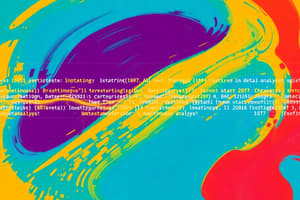Podcast
Questions and Answers
What syntax is required at the end of statements in Java?
What syntax is required at the end of statements in Java?
- Comma
- Colon
- Semicolon (correct)
- Period
How does Java handle variable types at compile time?
How does Java handle variable types at compile time?
- Types are known only at runtime
- Types must be declared explicitly (correct)
- Types are inferred randomly
- Types can change after declaration
What is a characteristic of dynamic typing as seen in Python?
What is a characteristic of dynamic typing as seen in Python?
- Types are determined at compile time
- Types are defined explicitly by the user
- Types cannot change once declared
- Types are inferred during runtime (correct)
Which of the following is a primitive type in Java?
Which of the following is a primitive type in Java?
What type of error does static checking find before the program runs?
What type of error does static checking find before the program runs?
Which of the following is an example of dynamic checking?
Which of the following is an example of dynamic checking?
What is NOT a characteristic of Java's variable types?
What is NOT a characteristic of Java's variable types?
Which of these statements regarding the scope of block statements in Java is true?
Which of these statements regarding the scope of block statements in Java is true?
What is the primary difference between static and dynamic software analysis?
What is the primary difference between static and dynamic software analysis?
What can dynamic software analysis help identify that static analysis might miss?
What can dynamic software analysis help identify that static analysis might miss?
What does the control flow graph represent in static software analysis?
What does the control flow graph represent in static software analysis?
What is a limitation of both static and dynamic checking?
What is a limitation of both static and dynamic checking?
Which testing method includes analyzing the program's structure?
Which testing method includes analyzing the program's structure?
Why is completeness abandoned in static software analysis?
Why is completeness abandoned in static software analysis?
What characterizes explicit data flow in software programs?
What characterizes explicit data flow in software programs?
Which of the following statements is true regarding testing methods?
Which of the following statements is true regarding testing methods?
What will be the value of variable 'c' after the statement 'c -= 3' in the first example?
What will be the value of variable 'c' after the statement 'c -= 3' in the first example?
What can be inferred from the variable 'b' in the second example if 'a' is deduced to be 0?
What can be inferred from the variable 'b' in the second example if 'a' is deduced to be 0?
In which scenario does implicit information flow occur based on the examples provided?
In which scenario does implicit information flow occur based on the examples provided?
What will happen in the first line of the last example if 'a' is less than 0?
What will happen in the first line of the last example if 'a' is less than 0?
In the third example, what is the purpose of the while loop?
In the third example, what is the purpose of the while loop?
What is the expected behavior when the value of 'a' changes from negative to non-negative in the third example?
What is the expected behavior when the value of 'a' changes from negative to non-negative in the third example?
Which statement about implicit data flow is correct based on the examples?
Which statement about implicit data flow is correct based on the examples?
In the second example, what is the significance of the value returned from 'getValue()'?
In the second example, what is the significance of the value returned from 'getValue()'?
Flashcards
Dynamically typed
Dynamically typed
A language where the type of an expression is resolved at runtime, meaning the code does not need to be explicitly typed.
Type
Type
A set of values with specific operations that can be performed on them. For example, integers, floats, and booleans.
Statically typed
Statically typed
A language where the type of an expression is checked before the program runs, ensuring type safety.
Java Syntax
Java Syntax
Signup and view all the flashcards
Python Syntax
Python Syntax
Signup and view all the flashcards
Runtime errors
Runtime errors
Signup and view all the flashcards
Compile-time errors
Compile-time errors
Signup and view all the flashcards
Logic errors
Logic errors
Signup and view all the flashcards
Implicit Information Flow
Implicit Information Flow
Signup and view all the flashcards
Control Flow Leakage
Control Flow Leakage
Signup and view all the flashcards
Timing Channel
Timing Channel
Signup and view all the flashcards
Exception Handling Leakage
Exception Handling Leakage
Signup and view all the flashcards
Memory Usage Leakage
Memory Usage Leakage
Signup and view all the flashcards
Attackers Exploiting Leaks
Attackers Exploiting Leaks
Signup and view all the flashcards
Example 1
Example 1
Signup and view all the flashcards
Example 2
Example 2
Signup and view all the flashcards
Static Software Analysis
Static Software Analysis
Signup and view all the flashcards
Dynamic Software Analysis
Dynamic Software Analysis
Signup and view all the flashcards
Control Flow Graph
Control Flow Graph
Signup and view all the flashcards
Intermediate Representation
Intermediate Representation
Signup and view all the flashcards
Explicit Data Flow
Explicit Data Flow
Signup and view all the flashcards
Testing
Testing
Signup and view all the flashcards
Software Analysis
Software Analysis
Signup and view all the flashcards
Checking techniques
Checking techniques
Signup and view all the flashcards
Study Notes
Software Analysis
- Software analysis aims to identify unintended behaviors, even if a program is technically correct. It considers contextual information.
- Static analysis examines the source code without running the program.
- Dynamic analysis executes the program to analyze its behavior.
Static Analysis
- The program needs translation into an intermediate representation.
- A control flow graph is built from the representation, but the intermediate representation doesn't include all possible program states.
Dynamic Analysis
- A control flow graph can quickly become complex.
- Dynamic analysis executes the program with different inputs to track the values of variables.
Explicit Information Flow
- Explicit flow occurs when information is copied or used in direct operations, like assigning a value.
- Consider example involving integer variables, assignments & calculations.
Implicit Information Flow
- Implicit flow is deduced from program behavior or variable values.
- If the program terminates, it might be possible to deduce the sign of a variable.
- The execution time can also convey information, even if the program ultimately finishes.
- An exception thrown reveals information about variables.
Java vs. Python
- Java uses static typing, meaning variable types are known at compile time.
- Python is dynamically typed, with type determination occurring at runtime.
- Java requires semicolons at statement endings and uses curly braces around code blocks.
- In Java, operators can be infix (between operands), prefix (before an operand), or postfix (after an operand).
Types in Java
- Java supports primitive types like
boolean,byte,short,int,long,float,double, andchar. - Operations on these types are functions.
- Operators and methods work on objects.
- There are pre-defined functions in Java.
Studying That Suits You
Use AI to generate personalized quizzes and flashcards to suit your learning preferences.




